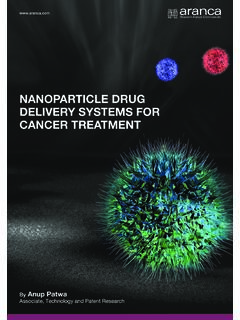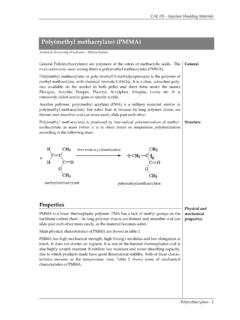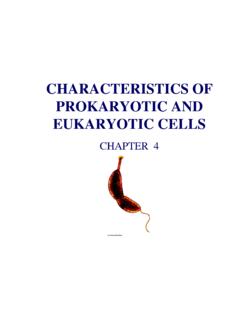Transcription of Perfluoroalkyl and Polyfluoroalkyl Substances (PFAS) Tech ...
1 Perfluoroalkyl and Polyfluoroalkyl Substances (PFAS). Methods and guidance for sampling and analyzing water and other environmental media Background Per- and Polyfluoroalkyl Substances (PFAS) are a group of synthetic chemicals that have been in use since the 1940s. PFAS are found in a wide array of consumer and industrial products. PFAS manufacturing and processing facilities, facilities using PFAS in production of other goods, airports, and military installations are some of the contributors of PFAS releases into the air, soil, and water . Due to their widespread use and persistence in the environment, most people in the United States have been exposed to PFAS. There is evidence that continued exposure above specific levels to certain PFAS may lead to In 2019, EPA published validated SW-846. adverse health effects. The Environmental Protection Method 8327 for non-potable water and Agency (EPA) will continue to partner with other federal Method 533 for analysis of short-chain PFAS.
2 Agencies, states, tribes, and local communities to protect in drinking water . human health and, where necessary and appropriate, to limit human exposure to potentially harmful levels of could not be analyzed using due to physicochemical PFAS in the environment. properties. In December 2019, EPA published Method EPA's methods for analyzing PFAS in environmental media 533, which includes a total of 25 PFAS (14 of the 18 PFAS. are in various stages of development and validation. The in plus an additional 11 short chain PFAS) and Agency is working to develop validated analytical specifies isotope dilution quantitation. methods for groundwater, surface water , wastewater, Health Advisories and solids, including soils, sediments, biota, and biosolids. In May 2016, EPA issued drinking water health advisories for two types of PFAS: perfluorooctanoic acid (PFOA) and Drinking water perfluorooctanesulfonic acid (PFOS).
3 EPA's health Analysis of PFAS using Method advisories are non-regulatory and non-enforceable, and To assess for potential human exposure to PFAS in are intended to provide technical information to state drinking water , EPA's validated Method will ensure agencies and other public health officials on health that both government and private laboratories can effects, analytical methodologies, and treatment effectively measure 18 PFAS in drinking water , which is a technologies associated with drinking water critical step for estimating exposure and potential health contamination. risks to PFAS. EPA Method 537 was first published in 2009. to initially determine 14 different PFAS. In 2018, the Non-Potable water method was updated to include 4 more PFAS, including Analysis of PFAS using SW-846 Method 8327. the GenX chemical hexafluoropropylene oxide dimer EPA developed a direct injection liquid chromatography acid (HFPO-DA).
4 Tandem mass spectrometry method, EPA SW-846 Method Analysis of Short-Chain PFAS using Method 533 8327, that utilizes external calibration for analysis of 24. EPA developed and validated EPA Method 533 to target PFAS in non-potable water (not of drinking quality). After short chain PFAS (none greater than C12), including a multi-lab validation in surface water , groundwater, and perfluorinated acids, sulfonates, fluorotelemers, and wastewater effluent, EPA posted the validated SW-846. poly/perfluorinated ether carboxylic acids. Many of these Method 8327 in June 2019 for public comment. 1 Environmental Protection Agency EPA/600/F-17/022h Updated January 2020. EPA SW-846 Method 8327 is available for public use while contain PFAS, they cannot be used in sampling for PFAS. EPA is adjudicating public comments. Consistent with In addition, many consumer goods brought to a sampling most SW-846 methods, EPA provides the method as site may contain PFAS that can contaminate samples.
5 Guidance; the use of this method is not specified in any Field sampling and laboratory hygiene protocols are federal testing requirements. Method 8327 is designed critical to ensuring that testing results reflect actual PFAS. for high-throughput applications and supports interim levels in the analyzed media. The Interstate Technology recommendations for groundwater contaminated with and Regulatory Council has summarized site PFOA and PFOS; however, for some analytes and characterization, sampling precautions, and analytical matrices, it may not be sensitive enough for very low- method issues and options through their fact sheet series. level ( , single ng/L) project requirements. Contacts Non-Potable water and other Technical Contacts Environmental Media Chris Impellitteri, Validation of SPE-ID Method for PFAS Analysis Schatzi Fitz-James, EPA is collaborating with the Department of Defense's Cynthia Caporale, Naval Seas Systems Command Laboratory Quality and Communications Contact Accreditation Office and SGS-AXYS to validate a solid- Michelle Latham, phase extraction/isotope dilution (SPE-ID) method.
6 The method will include solid matrices ( , soil, sediment, fish tissue, biosolids) in addition to non-drinking water Additional Information aqueous matrices. In addition to the 24 analytes included in draft SW-846 EPA Method : Method 8327, EPA plans to include additional analytes for the SPE-ID Method to include analytes recently added to ntryId=343042&Lab=NERL. EPA Method 537. Single-laboratory validation of the SPE- EPA Method 533: ID protocol is targeted for winter 2020 and multi- laboratory validation will likely follow in 2021. determination-and- Polyfluoroalkyl -substa nces- Evaluating Methods for Total PFAS Assessments drinking- water -isotope EPA will also begin evaluating methods for total organic SW-846 Method 8327: fluoride (TOF) analyses in 2020. An effective TOF method will facilitate broad assessments of total PFAS in and- Polyfluoroalkyl - Substances -pfas-usin g-external- environmental samples.
7 Standard Developing Sampling and Storage Methods PFOA & PFOS Drinking water Health Advisories: EPA ran time-based studies on degradation or loss of drinking- water -health-advisories-pfoa-an d-pfos target analytes during sample storage (45 days) and assessed the effects of different sample vessel materials UCMR3: contaminant-monitoring-rule ( , plastic, glass) on analyte recovery. Based on these sampling and storage studies, EPA methods under Interstate Technology and Regulatory Council development will recommend using PFAS-free, plastic PFAS Fact Sheets: containers ( , high-density polyethylene containers);. PFAS in Your Environment: whole sample preparation; and sample holding times of 28 days. EPA will also develop guidelines for field Clean-Up Information: sampling, which are critical for minimizing sample contamination and optimizing data quality for site Disclaimer: This document is for informational purposes characterization and remediation.
8 Only. Any mention of or reference to commercial products, processes, or services by trade name, trademark, Due to the widespread use of PFAS, many materials manufacturer, or otherwise does not imply an endorsement normally used in field and laboratory operations contain by the Government or the Environmental PFAS. For example, polytetrafluoroethylene products Protection Agency and shall not be used for advertising or (tubing, sample containers, and sampling tools) are often product endorsement purposes. EPA does not endorse any used in sampling; however, since these products can commercial products, services, or enterprises. 2 Environmental Protection Agency


















